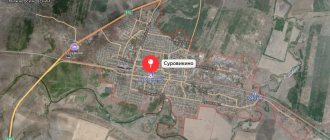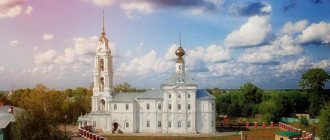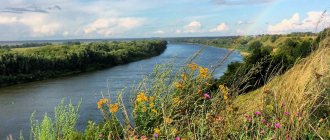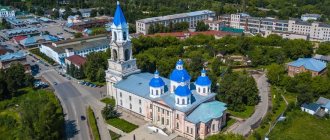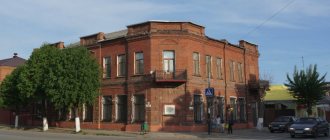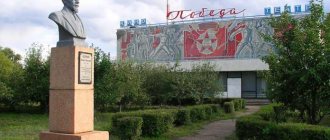History and sights of the regional center of Shilovo, Ryazan region
One of the large regional centers of the Ryazan region is the urban-type settlement of Shilovo. This region is considered the birthplace of the Russian heroes Evpatiy Kolovrat and Dobrynya Nikitich, as well as the poet Nikolai Gumilyov and academician philologist I.I. Sreznevsky. We have vacationed in this area more than once in the summer with friends. In good weather, you can spend whole days on the Oka River, enjoying beach holidays and fishing. And even residents of Ryazan, which is located a hundred kilometers from Shilovo, come to pick mushrooms in the surrounding forests. But even in autumn there is something to see in the Shilovsky district: these are ancient villages and estates associated with such big names as the Olsufievs, Lunins and Golitsyns. In addition, a huge number of ancient pre-Christian settlements have been found in the region, which are annually visited by archeology lovers from all over the country. Today my story is dedicated to advanced travelers who want to visit an interesting, but not well-known area of the Ryazan region.
Shilovo
For people traveling from Moscow to Kasimov and wanting to see such amazing estates of Baron von Derviz as Kiritsy and Starozhilovo, Shilovo is an excellent place for rest and overnight, as there are three small hotels and several cafes in the village.
Stories about Kasimov
Estate in Kiritsy
Excursion groups regularly come from Ryazan to Shilovo to visit the local history museum, one of the largest in the region, and the ethnocultural museum. In addition, in the summer, the village hosts the willow weaving festival “Iva-Ivushka” and “Neptune’s Day” with mass celebrations on the banks of the Oka. We often visit the Ryazan region, we love this region, and finally we managed to get to Shilovo.
Shilovo
Numerous excavations constantly carried out on the Shilovsky land prove the existence of settlements of ancient people here several thousand years before our era. Later, Finno-Ugric tribes began to inhabit the surrounding lands. Around the 10th-11th centuries, the Slavs came here, and the city of Nersk appeared on the right bank of the Oka, or it is also called Nerskoye. In the 14th century, the Ryazan princes transferred Nersk to the Shilovsky brothers, who came from Lithuania, and after that the city began to be called Shilov. In the 16th century, when the Ryazan principality was annexed to the Moscow principality, fortifications began to be erected in the vicinity of Shilovo to protect the borders of the state from the raid of the Tatars, because the Nogai Highway passed very close.
Shilovo
Until the 17th century, Shilovo was considered an important grain pier: ships paid a duty for transporting goods, which was collected only at three piers in this direction. And quite a few ships sailed here at that time: about 600 ships a year. Gradually, the borders of the state moved away, and Shilovo lost its border position, turning into a small village. At the end of the 19th century, the Kazan Railway was built through Shilovo. With the advent of Soviet power, the village began to gradually grow, turning into a regional center.
Legends of Shilovo, Ryazan region
In addition to the official versions of the origin of the name “Shilovo” and the founding of the village, there are also legends. The first suggests that there used to be impassable swamps here. One day a merchant who sold awl was driving past. He had goods for several convoys. One cart overturned, awls scattered on the ground, and the place began to be called Shilovo.
The second legend tells how three Russian hunters wandered into dense forests in the vicinity of the village of Borok. They wandered for a long time and finally came to the local Mordovian settlement. They were received kindly and the brothers were allowed to rest. One of the hunters fell in love with the daughter of a local prince and asked for her hand in marriage. The father flatly refused to consent to such a marriage. Then the brothers kidnapped the girl and fled. The Mordovian prince overtook them in the area of Shilovskaya Ryazanskaya Street and cut them into pieces. The girl, unable to bear the death of her beloved, rushed into the river as she left the village. Since the name of the daughter of the Mordovian prince was Parava, the river was named Para in her honor. At the same time, one of the hunter brothers still survived, although he was severely wounded. He began to pray for salvation and saw a falcon. He crawled after the bird and ended up on the banks of the Oka, where underground springs flow and medicinal herbs grow. The falcon brought food to the young man and gradually the hunter recovered. One day he saw something glowing floating along the river. He came closer and saw the icon of the Dormition of the Blessed Virgin Mary. The hunter then built a small church on the shore and began to live there. Gradually other houses began to appear around the temple, and that’s how Shilovo appeared.
And what to see in Shilovo?
Now it is a fairly large village, where there are three schools, a hospital, a sports complex with a swimming pool, a small hotel and a cultural center. In Soviet times, there was even a cinema “Cosmos”, which, unfortunately, ceased to exist. The ancient settlement was located in the area of the Assumption Church, originally built in the 14th century.
Shilovo
The modern stone building of the temple was erected in the middle of the 19th century at the expense of parishioners and the local landowner A. Kolemin according to the design of the Ryazan architect Voronikhin. Next to the Assumption Church there is a local history museum, which contains numerous archaeological finds from the excavation sites of ancient settlements, as well as various household items that tell about the life of people in Shilovo in different eras.
We move further towards the hospital, in the park of which there is a monument to the hero of the civil war, submariner, and later an active fighter against banditry in the Shilovsky district, Vasily Yakovlevich Isaev.
Shilovo
In May 1919, the submarine Lamprey fought with British intervention ships in the Caspian Sea and was seriously damaged, requiring it to be towed to a safe place. But, unfortunately, it turned out that the boat's propellers became entangled in the steel cables. Vasily Isaev volunteered to free the ship. To do this, he spent several hours in cold water without special diving equipment and completed the task, for which he was awarded the order. After demobilization, Isaev returned to his native village and joined the ranks of the police, and during his long service he neutralized more than one gangster group. Vasily Yakovlevich was a kind of Sharapov of the Shilov land.
Further on, on Sovetskaya Street, near the bank, a monument to the collective image of a local worker was erected on the trunk of an old linden tree.
Shilovo
But the most interesting monuments in Shilovo are the monuments to two Russian heroes. One rises on Sovetskaya Square in front of the Palace of Culture - this is the first Russian partisan Evpatiy Kolovrat.
Shilovo
Its homeland is the village of Frolovo, Shilovsky district. This Ryazan governor was away when the Tatar army attacked Ryazan in 1237 and destroyed the city. Returning home and seeing what a disaster had happened in his native land, Evpatiy with a small army rushed in pursuit, and having overtaken the Tatars, he began to beat them mercilessly. Despite the fact that the numerical superiority was on the side of Batu’s army, Kolovrat managed to destroy many of his soldiers. They say that Batu even sent messengers to ask what the hero needed. In response, Evpatiy Kolovrat replied: “Only die!” As a result, the Russian hero was nevertheless killed by the Tatars, but as a sign of respect for his bravery and courage, Batu handed over Kolovrat’s body to the surviving Russian soldiers and allowed him to be buried in his native land. The second famous character of Russian epics, one of the three heroes Dobrynya Nikitich, is also immortalized near Shilovo, on the road to the village of Pribrezhny. It’s worth driving just a few kilometers, and we see on a hill a shield and a sword, framed by the figure of a warrior.
Shilovo
This is the Dobrynin Kurgan, which appeared here quite recently. Several settlements of the Ryazan region are arguing for the right to be called the birthplace of the hero. However, they say that in pre-war times, a mound was discovered in the forest near the village of Pribrezhny, in which the remains of a warrior with a sword and a belt decorated with gold links were excavated. These finds fell into private hands and were never seen again. And people began to believe that they had found the body of the hero Dobrynya, who died in the battle.
Interesting sights in the vicinity of Shilovo
In addition, near Shilovo there are villages with an interesting history. For example, the village of Zheludevo is interesting, which is the paternal homeland of the famous poet Nikolai Gumilyov.
Village Zheludevo
Since 1676, there has been a wooden Church of the Nativity in the village. Later, in 1811, at the expense of the landowner Pyotr Mikhailovich Lunin, Mikhail Sergeevich’s uncle, who lived in the Lunino estate, they began to build a stone temple, which has survived to this day.
Ryazan Oblast
Pyotr Mikhailovich Lunin was famous for his extravagant behavior and was known as a great gourmet. They say that he came to a dinner party in Warsaw with his French cook. And when in 1812, Moscow residents hurriedly left their homes, and Napoleon’s army was approaching the capital, Pyotr Mikhailovich gave orders for dinner preparations in his house on Nikitsky Boulevard. Only after urgent persuasion from his relatives did Lunin become one of the last to leave the capital. Ironically, his house was one of the few that survived the fire.
The daughter of Pyotr Mikhailovich was the famous singer Ekaterina Petrovna Lunina-Ricci, who conquered both Europe and Russian high society with her singing. After the death of her father, she and her mother sold numerous estates in the Ryazan region, including the estate complex in the village of Zheludevo, and the village of Zadubrovye, in which at the moment only the Church of St. Nicholas the Wonderworker has survived.
Ryazan Oblast
By the way, Pyotr Mikhailovich Lunin was buried right in Zheludevo, and his funeral service was performed by priest Fyodor Gumilev, whose sister the grandfather of the famous poet Nikolai Gumilev, Yakov Panov, was married to. When he decided to marry the daughter of priest Grigory Gumilyov, a prerequisite for such a marriage was that the groom, who was the clerk of the local Nativity Church, would take his wife’s surname after the wedding. Their youngest son Stepan, the poet's father, graduated from the Ryazan theological educational institution, where medicine was taught as an additional subject. This is what Stepan Yakovlevich Gumilyov decided to devote his life to. Later, he graduated from Moscow University with a degree in medicine and began working as a doctor in Kronstadt. The poet’s mother was Anna Ivanovna Lvova, a representative of an old noble family. It is known that the poet and his family often spent the summer months on the Ryazan estate Berezki and visited his grandfather in Zheludevo. Quite a few old pre-revolutionary brick houses have still been preserved in this village. Near the Church of the Nativity you can see the remains of a manor house and an old cemetery. In addition, there is a club in the village, near which there is a very picturesque pond.
Ryazan Oblast
Village Inyakino
Another interesting settlement in the Shilovsky district is the village of Inyakino, where the remains of an ancient settlement have been preserved. The modern village was founded by the hero of the war of 1812, General Z.D. Olsufiev, who received it for services to the fatherland. With his funds, in the first half of the 19th century, the Assumption Church was built, which can be seen here and now. Even in our time, the size of the church, which was created by the labor of thousands of serfs, is amazing.
Ryazan Oblast
The architectural monuments of the Shilovsky district certainly deserve attention, but the main advantage of this region is its amazing nature: the high banks of the Oka, water meadows and dense forests rich in mushrooms and berries.
Ryazan Oblast
Ryazan Oblast
Ryazan Oblast
Holidays in such picturesque places allow you to escape from the bustle of the city and enjoy the quiet joys of the countryside.
Population
| Population | |||||
| 1959[3] | 1970[4] | 1979[5] | 1989[6] | 2002[7] | 2009[8] |
| 9424 | ↗12 685 | ↗13 965 | ↗18 374 | ↘16 572 | ↘15 978 |
| 2010[9] | 2012[10] | 2013[11] | 2014[12] | 2015[13] | 2016[1] |
| ↘15 669 | ↘15 461 | ↘15 142 | ↘14 917 | ↘14 853 | ↘14 720 |
An excerpt characterizing Shilovo (Shilovsky district)
“I’m glad with my soul that they came and that they stopped with me,” she said. “It’s high time,” she said, looking significantly at Natasha... “the old man is here and they are expecting their son any day now.” We must, we must meet him. Well, we’ll talk about that later,” she added, looking at Sonya with a look that showed that she didn’t want to talk about it in front of her. “Now listen,” she turned to the count, “what do you need tomorrow?” Who will you send for? Shinshina? – she bent one finger; - crybaby Anna Mikhailovna? - two. She's here with her son. My son is getting married! Then Bezukhova? And he's here with his wife. He ran away from her, and she ran after him. He dined with me on Wednesday. Well, and - she pointed to the young ladies - tomorrow I’ll take them to Iverskaya, and then we’ll go to Ober Shelme. After all, you will probably do everything new? Don't take it from me, these days it's sleeves, that's what! The other day, the young Princess Irina Vasilievna came to see me: I was afraid to look, as if she had put two barrels on her hands. After all, today the day is a new fashion. So what are you doing? – she turned sternly to the count. “Everything suddenly came together,” answered the count. - To buy rags, and then there is a buyer for the Moscow region and for the house. If you're so kind, I'll find some time, go to Marinskoye for a day, and show you my girls. - Okay, okay, I’ll be intact. It’s like in the Board of Trustees. “I’ll take them where they need to go, scold them, and caress them,” said Marya Dmitrievna, touching the cheek of her favorite and goddaughter Natasha with her big hand. The next day, in the morning, Marya Dmitrievna took the young ladies to Iverskaya and to m me Ober Shalma, who was so afraid of Marya Dmitrievna that she always gave her outfits at a loss, just to get her out of her hands as quickly as possible. Marya Dmitrievna ordered almost the entire dowry. When she returned, she kicked everyone except Natasha out of the room and called her favorite to her chair. - Well, now let's talk. Congratulations on your fiance. Got the guy! I'm happy for you; and I’ve known him since those years (she pointed to an arshin from the ground). – Natasha blushed joyfully. – I love him and his whole family. Now listen. You know, old Prince Nikolai really did not want his son to get married. Good old man! It is, of course, Prince Andrei is not a child, and he will manage without him, but it is not good to enter the family against his will. It must be peaceful, loving. You're smart, you can do it right. Treat yourself kindly and wisely. Everything will be fine. Natasha was silent, as Marya Dmitrievna thought, out of shyness, but in essence Natasha was unpleasant that they were interfering in her love affair with Prince Andrei, which seemed to her so special from all human affairs that no one, according to her concepts, could understand it. She loved and knew one Prince Andrei, he loved her and was supposed to come one of these days and take her. She didn't need anything else. “You see, I’ve known him for a long time, and I love Mashenka, your sister-in-law.” Sisters-in-law are beaters, but this one won’t hurt a fly. She asked me to set her up with you. Tomorrow you and your father will go to her, and give her a good hug: you are younger than her. Somehow yours will arrive, and you already know your sister and father, and they love you. Yes or no? Surely it will be better? “Better,” Natasha answered reluctantly. The next day, on the advice of Marya Dmitrievna, Count Ilya Andreich went with Natasha to Prince Nikolai Andreich. The count prepared for this visit with a gloomy spirit: in his heart he was afraid. The last meeting during the militia, when the count, in response to his invitation to dinner, listened to a heated reprimand for not delivering people, was memorable for Count Ilya Andreich. Natasha, dressed in her best dress, was on the contrary in the most cheerful mood. “It’s impossible that they wouldn’t love me,” she thought: everyone has always loved me. And I’m so ready to do for them whatever they want, I’m so ready to love him - because he’s a father, and she’s because she’s a sister, that there’s no reason why they wouldn’t love me!” They drove up to an old, gloomy house on Vzdvizhenka and entered the hallway. “Well, God bless,” said the count, half jokingly, half seriously; but Natasha noticed that her father was in a hurry, entering the hall, and timidly, quietly asked if the prince and princess were at home. After the report of their arrival, there was confusion among the prince's servants. The footman, who ran to report them, was stopped by another footman in the hall and they whispered about something. A girl, a maid, ran out into the hall and also hurriedly said something, mentioning the princess. Finally, one old footman with an angry look came out and reported to the Rostovs that the prince could not receive him, but the princess was asking to come to her. M lle Bourienne was the first to greet the guests. She especially politely met the father and daughter and took them to the princess. The princess, with an excited, frightened face covered with red spots, ran out, stepping heavily, towards the guests, and tried in vain to appear free and welcoming. Princess Marya did not like Natasha at first sight. She seemed too elegant, frivolously cheerful and vain to her. Princess Marya did not know that before she saw her future daughter-in-law, she was already ill-disposed towards her out of involuntary envy of her beauty, youth and happiness and out of jealousy of her brother’s love. In addition to this irresistible feeling of antipathy towards her, Princess Marya at that moment was also excited by the fact that at the report of the Rostovs’ arrival, the prince shouted that he did not need them, that he should let Princess Marya receive them if she wanted, and that they should not be allowed to see him . Princess Marya decided to receive the Rostovs, but every minute she was afraid that the prince would do some kind of trick, since he seemed very excited about the Rostovs’ arrival. “Well, dear princess, I brought you my songbird,” said the count, shuffling and looking around restlessly, as if he was afraid that the old prince might come up. “I’m so glad that you met... It’s a pity, it’s a pity that the prince is still unwell,” and after saying a few more general phrases, he stood up. “If you would allow me, princess, to give you an idea of my Natasha for a quarter of an hour, I would go, just two steps away, to the Dog Playground, to see Anna Semyonovna, and pick her up.” Ilya Andreich came up with this diplomatic trick in order to give his future sister-in-law space to explain himself to his daughter-in-law (as he said this after his daughter) and also in order to avoid the possibility of meeting with the prince, whom he was afraid of. He did not tell this to his daughter, but Natasha understood this fear and anxiety of her father and felt insulted. She blushed for her father, became even more angry for blushing, and looked at the princess with a bold, defiant look that said that she was not afraid of anyone. The princess told the count that she was very happy and only asked him to stay longer with Anna Semyonovna, and Ilya Andreich left. M lle Bourienne, despite the restless glances thrown at her by Princess Marya, who wanted to talk with Natasha face to face, did not leave the room and firmly held the conversation about Moscow pleasures and theaters. Natasha was offended by the confusion that occurred in the hallway, by her father’s anxiety and by the unnatural tone of the princess, who, it seemed to her, was doing a favor by accepting her. And then everything was unpleasant for her. She didn't like Princess Marya. She seemed very bad-looking to her, feigned and dry. Natasha suddenly shrank morally and involuntarily adopted such a careless tone, which pushed Princess Marya away from her even more. After five minutes of heavy, pretend conversation, fast footsteps in shoes were heard approaching. Princess Marya's face expressed fear, the door of the room opened and the prince entered in a white cap and robe. “Oh, madam,” he said, “madam, countess... Countess Rostova, if I’m not mistaken... I beg your pardon, excuse me... I didn’t know, madam.” God knows, I didn’t know that you honored us with your visit; you came to see your daughter in such a suit. I beg your pardon... God sees, I didn’t know,” he repeated so unnaturally, emphasizing the word God and so unpleasantly that Princess Marya stood with her eyes downcast, not daring to look at either her father or Natasha. Natasha, having stood up and sat down, also did not know what to do. One m lle Bourienne smiled pleasantly. - I beg your pardon, I beg your pardon! “God knows, I didn’t know,” the old man muttered and, having examined Natasha from head to toe, he left. M lle Bourienne was the first to appear after this appearance and began a conversation about the prince’s ill health. Natasha and Princess Marya silently looked at each other, and the longer they silently looked at each other, without expressing what they needed to express, the more unkindly they thought about each other. When the count returned, Natasha was discourteously delighted with him and hurried to leave: at that moment she almost hated this dry old princess, who could put her in such an awkward position and spend half an hour with her without saying anything about Prince Andrei. “After all, I couldn’t be the first to start talking about him in front of this French woman,” thought Natasha. Princess Marya, meanwhile, suffered from the same thing. She knew that she had to tell Natasha, but she could not do it both because M lle Bourienne interfered with her, and because she herself did not know why it was so difficult for her to start talking about this marriage. When the count was already leaving the room, Princess Marya quickly walked up to Natasha, took her hands and, sighing heavily, said: “Wait, I need...” Natasha looked at Princess Marya mockingly, not knowing why. “Dear Natalie,” said Princess Marya, “know that I am glad that my brother has found happiness...” She stopped, feeling that she was telling a lie. Natasha noticed this stop and guessed the reason for it. “I think, princess, that now it’s inconvenient to talk about this,” Natasha said with outward dignity and coldness and with tears that she felt in her throat. “What did I say, what did I do!” she thought as soon as she left the room.
Literature
- Chronicle according to the Ipatiev list - St. Petersburg, 1871, S-248,249.
- A chronicle collection called the Patriarchal or Nikon Chronicle PSRL. T.9., M.2000, P.172.
- Moscow chronicle code of the late 15th century - PSRL. t.25, M.-L., 1949., L.47.
- “Extract from the grant and tarkhan charter of the Ryazan Grand Duke Oleg Ivanovich, included in the unknown charter of the Ryazan bishop Vasily-2 for the Military district and Zasechye with land, in exchange for Glebov “mistletoe” with the district and Voronsky district received from the bishop” // Tsepkov, A. I. Collection of written sources on the history of the Ryazan region. XIV-XVII centuries. T.3, A.I. Tsepkov. - Ryazan, 2005.- P.112.
- The hundredth charter, given in 1576-1568. scribes Ivan Yuryevich Trakhaniotov with comrades on the land holdings of the Ryazan and Murom rulers - Tsepkov, A. I. Ryazan landowners of the XIV-XVI centuries - Ryazan, 1995.
- 11 June 1584. Legal charter given to Timofey Shilovsky and Job Zapolsky and his relatives in their case with clerk Andrei Sherefedinov about the “tortured” bill of sale - Tsepkov, A.I. Collection of written sources on the history of the Ryazan region of the XIV-XVII centuries. - T. 2. - Ryazan, 2005., p.442
- Kondrashov A. I. Nerinsk (Shilovo) - the chronicle sister city of Moscow - Russian scientific journal No. 2 (15) 2010. Publisher: ANO "Riepsi"
- Kondrashov A.I. On the issue of historical continuity of the ancient Russian cities of Nerinsk (Nerilsk) and Shilovo - “Materials and research on Ryazan local history.” Editorial board: B.V. Gorbunov, L.V. Dimperan, I.Zh. Ryndin, A.I. Khvostov, M.V. Tselikova, V.P. Chelyapov, I.N. Yukhina. RIRO, vol. 14., Ryazan, 2007, pp. 52-55.
- Kondrashov A.I. The Battle of Shishevsky Forest on the Military Homeland of the First Russian Victories. - Russian scientific journal No. 2 (9) 2009. p. 17-46, Ryazan, publishing house: ANO "Riepsi"
- Kuzmin, A. G. Ryazan chronicle - A. G. Kuzmin., M., 1965., p. 211-212.
- Shilovo (Shilovsky district)
- article from the Great Soviet Encyclopedia. - [terrus.ru/cgi-bin/allrussia/v3_index.pl?act=reg&id=62 terrus.ru - Russian database]
Notes
- ↑ 12
www.gks.ru/free_doc/doc_2016/bul_dr/mun_obr2016.rar Population of the Russian Federation by municipalities as of January 1, 2016 - THE USSR. Administrative-territorial division of the union republics on January 1, 1980 / Compiled by V. A. Dudarev, N. A. Evseeva. - M.: Publishing house "Izvestia of the Soviets of People's Deputies of the USSR", 1980. - 702 p. — P. 210.
- [demoscope.ru/weekly/ssp/rus59_reg2.php All-Union Population Census of 1959. The size of the urban population of the RSFSR, its territorial units, urban settlements and urban areas by gender] (Russian). Demoscope Weekly. Retrieved September 25, 2013. [www.webcitation.org/6GDOghWC9 Archived from the original on April 28, 2013].
- [demoscope.ru/weekly/ssp/rus70_reg2.php All-Union Population Census of 1970 The size of the urban population of the RSFSR, its territorial units, urban settlements and urban areas by gender.] (Russian). Demoscope Weekly. Retrieved September 25, 2013. [www.webcitation.org/6GDOiMstp Archived from the original on April 28, 2013].
- [demoscope.ru/weekly/ssp/rus79_reg2.php All-Union Population Census of 1979 The size of the urban population of the RSFSR, its territorial units, urban settlements and urban areas by gender.] (Russian). Demoscope Weekly. Retrieved September 25, 2013. [www.webcitation.org/6GDOjhZ5L Archived from the original on April 28, 2013].
- [demoscope.ru/weekly/ssp/rus89_reg2.php All-Union Population Census of 1989. Urban population]. [www.webcitation.org/617x0o0Pa Archived from the original on August 22, 2011].
- [www.perepis2002.ru/ct/doc/1_TOM_01_04.xls All-Russian Population Census 2002. Volume. 1, table 4. Population of Russia, federal districts, constituent entities of the Russian Federation, districts, urban settlements, rural settlements - regional centers and rural settlements with a population of 3 thousand or more]. [www.webcitation.org/65AdCU0q3 Archived from the original on February 3, 2012].
- [www.gks.ru/bgd/regl/B09_109/IssWWW.exe/Stg/d01/tabl-21-09.xls Number of permanent population of the Russian Federation by cities, urban-type settlements and districts as of January 1, 2009]. Retrieved January 2, 2014. [www.webcitation.org/6MJmu0z1u Archived from the original on January 2, 2014].
- [ryazan.gks.ru/wps/wcm/connect/rosstat_ts/ryazan/resources/090fe1004fa3853290b698ca6ff6f188/11.+Population+of+Ryazan+region%2C+urban+districts%2C+municipal+districts%2C+urban+and+ rural+settlements.htm All-Russian population census 2010. 11. Population of the Ryazan region, urban districts, municipal districts, urban and rural settlements]. Retrieved December 10, 2013. [www.webcitation.org/6Lkv122fy Archived from the original on December 10, 2013].
- [www.gks.ru/free_doc/doc_2012/bul_dr/mun_obr2012.rar Population of the Russian Federation by municipalities. Table 35. Estimated resident population as of January 1, 2012]. Retrieved May 31, 2014. [www.webcitation.org/6PyOWbdMc Archived from the original on May 31, 2014].
- [www.gks.ru/free_doc/doc_2013/bul_dr/mun_obr2013.rar Population of the Russian Federation by municipalities as of January 1, 2013. - M.: Federal State Statistics Service Rosstat, 2013. - 528 p. (Table 33. Population of urban districts, municipal districts, urban and rural settlements, urban settlements, rural settlements)]. Retrieved November 16, 2013. [www.webcitation.org/6LAdCWSxH Archived from the original on November 16, 2013].
- [www.gks.ru/free_doc/doc_2014/bul_dr/mun_obr2014.rar Table 33. Population of the Russian Federation by municipalities as of January 1, 2014]. Retrieved August 2, 2014. [www.webcitation.org/6RWqP50QK Archived from the original on August 2, 2014].
- [www.gks.ru/free_doc/doc_2015/bul_dr/mun_obr2015.rar Population of the Russian Federation by municipalities as of January 1, 2015]. Retrieved August 6, 2015. [www.webcitation.org/6aaNzOlFO Archived from the original on August 6, 2015].
Status
Municipal entity - Shilovsky municipal district is an independent municipal entity within the Ryazan region.
The Shilovsky district in its current form was formed in 1965 by the Decree of the Presidium of the Supreme Soviet of the RSFSR dated January 12, 1965.
The charter of the municipal formation - Shilovsky municipal district was adopted by decision of the Council of Deputies on January 24, 1997 No. 6.
The current version of the Charter was adopted by a decision of the Council of Deputies dated December 20, 2010. No. 16/162) (Registered in the department of the Main Directorate of the Ministry of Justice of the Russian Federation for the Central Federal District in the Ryazan region on January 13, 2011).
Climate, minerals, water resources, soils, forests
The climate of the area is temperate continental, with warm summers and moderately cold winters. Precipitation is distributed unevenly throughout the year.
Mineral resources – peat, building stones, clays, sand for road construction, phosphates.
Water resources are determined by the rivers Oka, Para, Tyrnitsa, Vechug, Srednik and others. Of the lakes, the largest are lakes San, Chudino, Tish, Glubokoe.
Soils. The main part of the territory of the municipal formation is occupied by soddy-podzolic (53.2%) and gray forest soils (43.6%). They have a predominantly light mechanical composition and require organic and mineral fertilizers.
Forests occupy about 27.5% of the district's territory. In the northeastern and eastern parts there is the Erakhturskoye forestry, in the central - the Pervomaiskoye forestry, in the southern - the Shelukhovskoye forestry.
Transport
Shilovo is a transport hub where road, rail, river and pipeline modes of transport intersect:
- The “historical” direction of the Trans-Siberian Railway is an electrified double-track railway. Station of the same name and locomotive facilities, without rolling stock maintenance.
- The federal highway M5 "Ural" intersects with the regional highway R-125.
- Oka river shipping route with a pier.
- Near the village there are the main oil pipeline Nizhny Novgorod - Ryazan and the main gas pipeline Central Asia - Center, which have pumping stations.
Administrative division
The municipality includes 2 urban settlements :
— Shilovskoye (Shilovo settlement) – 4 settlements: Shilovo village, village. Borok, Krivtsovo village, New Life village.
— Lesnovskoye (Lesnoy settlement) – 11 settlements: Lesnoy village, village. Alehovo, Krasny Luch village, Munyakovskie Vyselki village, Novaya Derevnya village, village. Novaya Pustyn, Novoershovo village, Yamskoy village, Zeleny Bor village, Malinovka village, Novomosolovsky village.
and 15 rural settlements :
— Adelinskoye (village Adelino) – 11 settlements: village. Adelino, Krasny Khutor village, Krylovka village, Nekrasovka village, Orekhovka village, Sverdlovka village, Sergievka village 1, Sergievka village 2, Smirnovka village, village. Nasledniche, village Narezka.
— Borkovskoe (village Borki) – 5 settlements: village. Borki, Kopanovo village, Polevoy village, Svinchus, Simakino village.
— Borovskoye (Borovoe village) – 6 settlements: village. Borovoe, Aleksandrovka village, Vanchur village, Elizavetinka village, Konstantinovka village, Usha village.
— Erakhturskoe (village Erakhtur) – 7 settlements: village. Erakhtur, s. Kuzemkino, Ladyshkino village, Maksheevo village, Mordasovo village, village. Rubetskoye, s. Narmushad,
— Zheludevskoye (village Zheludevo) - 3 settlements: village. Zheludevo, village Avdotinka, village. Sanovka.
— Zanino-Pochinkovskoye (village Zanino-Pochinki) – 14 settlements: village. Zanino-Pochinki, Belorechensky village, village. Ilebniki, s. Lubonos, village Munor, village Salaur, village Pavlovka, village Pogari, village. Bolshie Peksely, village of Malye Peksely, village. Muscle, p. Vyaz, Shemyakino village, Proletarsky village.
— Zadubrovskoe (village Zadubrovye) – 8 settlements: village. Zadubrovye, village Krutitsy, Myshkar village, s. Pustopolye, Bortnikovo village, village. Konstantinovo, s. Lunino, s. Sreznevo.
— Ibredskoye (Molodezhny settlement) – 2 settlements: Ibred village, Sasykino village.
— Inyakinskoye (village Inyakino) – 3 settlements: village. Inyakino, Poltavka village, Seltso-Sergievka village.
— Krasnokholmskoye (village Krasny Kholm) – 4 settlements: village. Krasny Kholm, Krasnokholmskie Vyselki village, Neplozha village, Chembar village.
— Mosolovskoye (Mosolovo village) – 15 settlements: village. Mosolovo, Voruzhka village, Zapolye village, Ivanovka village, Krasnogvardeisky village, Maryiny Khutora village, Nikolaevka village, Frolovo village, Shelukhovo village, Muratovo, Debra village, village. Cassocks, Sloboda village, Yasakovsky village, Taidakovo village.
— Sanskoye (Sanskoye village) – 3 settlements: village. Sanskoye, Fedoseevo-Pustyn village, Yushta.
— Tyrnovskoye (Tyrnovo village) – 3 settlements: village. Tyrnovo, village Akulovo, village. Dubrovka.
— Timoshkinskoye (Timoshkino village) – 6 settlements: village. Timoshkino, Kharinsky village, Rucheek, village. Berezovo, Krasny village, Pervomaisky village, Krasnaya Olkhovka village.
— Terekhovskoe (Terekhovo village) – 3 settlements: village. Terekhovo, s. Iritsy, s. Nadeino.
Famous people
See also category: Born in Shilov (Shilovsky district)
- Konovalova Svetlana Igorevna (born 1990) is a Russian biathlete and skier, champion of the 2014 Paralympic Games in Sochi.
- Grachev Nikolai Fedorovich (1930-2013) - Soviet military leader, army general.
- Voevodin Valentin Vasilievich (1934-2007) - Russian mathematician, academician of the Russian Academy of Sciences.
In the village of Sreznevo, Shilovsky district, the famous linguist Izmail Ivanovich Sreznevsky was buried, and a museum was created in his father’s house.
